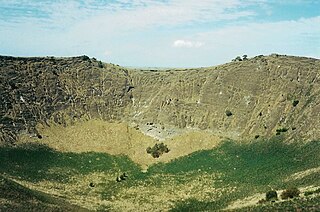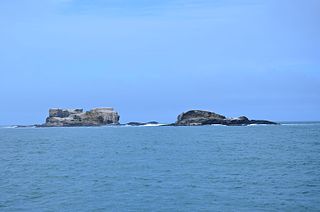James Grant was a Scottish born British Royal Navy officer and navigator in the early nineteenth century. He served in Australia in 1800-1801 and was the first to map the Bass Strait between mainland Australia and Tasmania.

Jules Pierre Verreaux was a French botanist and ornithologist and a professional collector of and trader in natural history specimens. He was the brother of Édouard Verreaux and nephew of Pierre Antoine Delalande.

Verreaux's eagle is a large, mostly African, bird of prey. It is also called the black eagle, especially in southern Africa, not to be confused with the black eagle of south and southeast Asia. The Verreaux's eagle lives in hilly and mountainous regions of southern and eastern Africa, and very locally in the Middle East.

His Majesty's Armed Survey Vessel Lady Nelson was commissioned in 1799 to survey the coast of Australia. At the time large parts of the Australian coast were unmapped and Britain had claimed only part of the continent. The British Government were concerned that, in the event of settlers of another European power becoming established in Australia, any future conflict in Europe would lead to a widening of the conflict into the southern hemisphere to the detriment of the trade that Britain sought to develop. It was against this background that Lady Nelson was chosen to survey and establish sovereignty over strategic parts of the continent.

Cape Liptrap is located in south Gippsland, Victoria and is a peninsula that is the extension of the Hoddle Range that runs out to sea in a southwesterly direction. With a latitude of 38° 53' 60" S it the second most southerly point on the Australian mainland, just south of Cape Otway which lies to the west. Wilsons Promontory which is the most southerly point sits to the southeast separated from Cape Liptrap by Waratah Bay.

Mount Schank is a 100 m (330 ft) high dormant volcano in the southeast corner of South Australia, near Mount Gambier. It was sighted by James Grant on 3 December 1800 and named after Admiral John Schank, designer of Grant's ship, HMS Lady Nelson.

Admiral John Schank was an officer of the British Royal Navy known for his skill in ship construction and mechanical design.

Rodondo Island is a granite island, part of the Rodondo Group, lying in northern Bass Strait, within the state boundaries of Tasmania, Australia. The island is located only 10 kilometres (6.2 mi) south of Wilsons Promontory in Victoria, and 2' of latitude south of the Victoria-Tasmania border at latitude 39°12'S. Rodondo Island is ringed by steep cliffs up to 200 metres (660 ft) high, with an area of 106 hectares and a maximum elevation of 350 metres (1,150 ft) above sea level.

The blue quail or African blue quail is a species of bird in the family Phasianidae found in sub-Saharan Africa.

The yellow-rumped tinkerbird is a bird species in the family Lybiidae, which is native to the moist tropical and subtropical regions of sub-Saharan Africa.

Tricholaema is a bird genus in the African barbet family Lybiidae. It was formerly included with the New World barbets in the family Capitonidae and sometimes also in the Ramphastidae.

Curtis Island is a granite island, with an area of 150 ha, in south-eastern Australia. It is part of Tasmania’s Curtis Group, lying in northern Bass Strait between the Furneaux Group and Wilsons Promontory in Victoria. It is a nature reserve and has been identified as an Important Bird Area because it supports up to 390,000 breeding pairs of short-tailed shearwaters or Tasmanian muttonbirds.

Devils Tower comprises two small and rugged granite islands, with a combined area of 4.77 hectares, in south-eastern Australia. It is part of Tasmania’s Curtis Group, lying in northern Bass Strait between the Furneaux Group and Wilsons Promontory in Victoria. It is a nature reserve.
West Moncoeur Island is a granite island, ringed by steep cliffs, with an area of 9.18 ha, in south-eastern Australia. It is part of Tasmania’s Rodondo Group, lying in northern Bass Strait south of Wilsons Promontory in Victoria. It is a nature reserve.
East Moncoeur Island is a granite island, with an area of 14 ha.

Churchill Island is a 50.7-hectare (125.3-acre) island in Western Port, Victoria, Australia. It is connected by a bridge to Phillip Island, which is in turn connected to the mainland by another bridge. It is the site of the first European garden in Victoria. It contains a working farm, cottages dating from the 1860s and a homestead dating from 1872, all fully restored and open to the public. The island adjoins the 670-hectare (1,656-acre) Churchill Island Marine National Park. The island is maintained by Phillip Island Nature Parks.

The Lawrence Rocks are a group of two rocky islets, 6.8 ha and 1.5 ha in area, with an associated reef, 2.4 km south-east of Point Danger in western Victoria, Australia, and about 6 km south-east of the city of Portland. Geologically, the group is formed from the remnants of an extinct volcano, with the islets composed of basalt and tuff.
Great Glennie Island is a small, rugged, granite island in the Glennie group of islands off the west coast of Wilsons Promontory, Victoria, Australia. It is part of the Wilsons Promontory Islands Important Bird Area, identified as such by BirdLife International because of its importance for breeding seabirds.
Seal Rocks comprises two small islets – Seal Rock and Black Rock – 1.5 kilometres (0.9 mi) south-west of Phillip Island in Victoria, Australia at the western entrance to Western Port.
The Dehler 22 is a West German trailerable sailboat that was designed by E. G. van de Stadt and first built in 1983. It is van de Stadt's design number 374.













